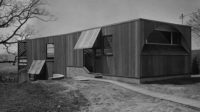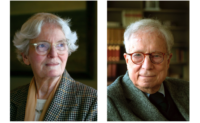Fifty Years After ‘Learning from Las Vegas,’ Denise Scott Brown Gets Her Due
Review: 'Denise Scott Brown In Other Eyes: Portraits of an Architect,' edited by Frida Grahn


Denise Scott Brown In Other Eyes: Portraits of an Architect, edited by Frida Grahn. Birkhäuser, 256 pages.
The ugly debate over the future of the Venturi, Scott Brown, and Associates-designed Sainsbury Wing of London’s National Gallery gives me a strong sense of deja vu. It was just a few years ago, in 2018, that I argued in two essays and a widely circulated petition that a plan to expand the firm’s Museum of Contemporary Art in La Jolla be redesigned with a greater appreciation for and sensitivity to Venturi and Scott Brown’s work. But in the ensuing controversy—as in the controversy over the Sainsbury Wing—this point has been lost in a sea of caricatures. The question taken up in the media and on Twitter has instead become whether a museum has the right to evolve with the times (of course it does), or whether it must instead be preserved in aspic on account of the fame of its architects (of course it should not be). This shift in terms has done a disservice to all involved. After all, rigid preservationism has never characterized the work of Denise Scott Brown and Robert Venturi, and it is not what drives Scott Brown’s concerns over the future of her work in London.
All this helps explain why Denise Scott Brown In Other Eyes, a new anthology edited by the Swiss architect and historian Frida Grahn, whose publication coincides with the 50th anniversary of Learning from Las Vegas, comes as so welcome a corrective. The book is, remarkably, the first collection of writings dedicated solely to Scott Brown, and as such it marks a new and long overdue beginning for scholars—an invitation to give serious consideration to Scott Brown that one hopes will be taken up widely in the coming years. Even on its own, this 300-page overture begins to tease out the disparate strands of Scott Brown’s thought as they developed over the course of a seven-decade career spanning from South Africa to London to Philadelphia, with subsequent travels to Los Angeles and Las Vegas. The picture that emerges has a complexity and nuance befitting its subject.
To good effect, Grahn cast a wide net in soliciting contributions. Among the 23 texts are personal remembrances, including a lovely essay by Scott Brown’s close friend Robin Middleton on a 1951 exhibition in Johannesburg; scholarly papers by established and emerging historians; and reflections by practitioners, among which is a thoughtful piece by Inès Lamunière and an interview Grahn conducted with Jacques Herzog. These are presented in three loosely chronological sections titled “1950s: Learning,” “1960s: Teaching,” and “1970s –2020s: Designing."

Denise Scott Brown, Wissahickon Avenue, Philadelphia, 2019. Photo by Carl C. Paatz
Scott Brown herself contributed an epistolary epilogue, which takes the form of a series of emails sent in 2022. Writing has always been one of Scott Brown’s great strengths, and these informal and lively missives reveal the same sharp mind, restless curiosity, and perceptive eye that were the generative forces behind Learning from Las Vegas and so many memorable essays. For me, as for so many other students of architecture, those writings opened up vast new domains of thought: you could learn from anything, Scott Brown suggested, as long as you learned to keep your eyes open, find rigorous tools of analysis, and always question received orthodoxies.
For Scott Brown, writing, photography, architecture, and planning have all been interlinked ways of grappling with the realities of a tragic and fragmented world. As Christopher Long writes in an essay in this volume, Scott Brown’s Postmodernism—understood more as a social and political movement than an architectural one—grew out of “experiences of exile, of the dislocations of modern life, and the supreme shock of the Shoah.” This loss of innocence, which manifested in a suspicion of the grand visions of urban renewal as well as of the artificial divide between high and low architecture, left irony as one of the few tools available to the postwar designer. “We use irony as a way to laugh so we don’t cry,” as Scott Brown famously put it in a 1975 interview, cited here in an excellent essay by Valéry Didelon linking Scott Brown’s thinking to Susan Sontag’s writing on camp.

Los Angeles, 1967. Photo by Denise Scott Brown, courtesy Denise Scott Brown
Understood in these broader terms, Scott Brown and Venturi’s built work, too, takes on a greater significance. Far from exhibits of “Postmodernism” in a preservationist’s museum of architectural styles, these buildings and urban interventions question received notions of beauty and meaning, jolting their audiences awake to uncomfortable realities. Beyond their functional intelligence, they deploy aesthetics to punch up rather than down, and one suspects that this is the ultimate reason that they have long inspired impassioned dislike among purveyors of good taste. By enabling readers to place these works in intellectual context, Denise Scott Brown In Other Eyes serves as a useful and timely reminder of the acuity and social agency that this work possesses—and of the empathetic vision of design that it puts forward.

Las Vegas signage, 1966. Photo by Denise Scott Brown, courtesy Denise Scott Brown
In honor of the release of Denise Scott Brown In Other Eyes and the 50th anniversary of Learning from Las Vegas, two events explored the legacy of Denise Scott Brown:
Denise Scott Brown: A Symposium
Yale School of Architecture
February 8, 1:30 pm EST
Book Talk: Denise Scott Brown In Other Eyes
New York Center for Architecture
February 10, 6:00 pm EST





